Paying Sustainability Forward
San Luis Obispo firm implements far-reaching changes
by Heather Livingston
Contributing Editor
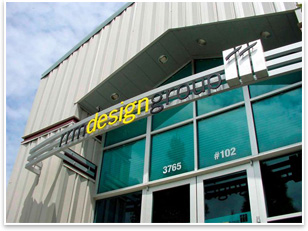 Summary: When RRM Design Group decided to seek LEED®-EB (“existing buildings”) for their newly purchased headquarters building in San Luis Obispo, Calif., the design firm committed not just to lessening the building’s ecological footprint, but also to evaluating the impact of their daily decisions from purchasing bottled water to using a fax machine. The facility was awarded LEED Gold in April 2008. Summary: When RRM Design Group decided to seek LEED®-EB (“existing buildings”) for their newly purchased headquarters building in San Luis Obispo, Calif., the design firm committed not just to lessening the building’s ecological footprint, but also to evaluating the impact of their daily decisions from purchasing bottled water to using a fax machine. The facility was awarded LEED Gold in April 2008.
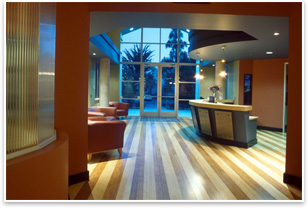 The RRM headquarters facility occupies a 25,000-square-foot building that originally was a manufacturing warehouse for sportswear company Hind. RRM’s renovation improves the facility’s environmental performance and occupant health and blends aesthetics with energy-efficient materials and systems. “Our goal to become LEED certified aligns directly with our company culture and was based on our dual passions of creating healthy spaces and running a great business—for our employees, our clients, and our environment,” says RRM Principal Stacey White, AIA, LEED-AP. The RRM headquarters facility occupies a 25,000-square-foot building that originally was a manufacturing warehouse for sportswear company Hind. RRM’s renovation improves the facility’s environmental performance and occupant health and blends aesthetics with energy-efficient materials and systems. “Our goal to become LEED certified aligns directly with our company culture and was based on our dual passions of creating healthy spaces and running a great business—for our employees, our clients, and our environment,” says RRM Principal Stacey White, AIA, LEED-AP.
With nearly 100 architects, civil engineers, landscape architects, planners, and surveyors working in the headquarters, RRM recognized the importance of earning employee buy-in. “We went through a priority-setting exercise where staff members were given the opportunity to say what features are most important,” recalls White. The features that employees identified as critical were access to daylight and fresh air and “a face that reflected our mission.” As a result of the exercise, natural daylight now reaches 76 percent of RRM’s regularly occupied work spaces.
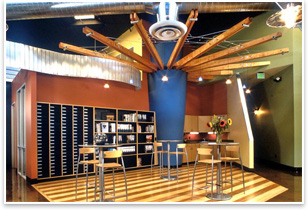 Being green and saving green Being green and saving green
Other sustainable systems and materials used in the renovation include a mechanical system combined with a louver system that optimizes fresh-air ventilation, rapidly renewable bamboo flooring, recyclable carpets made from recycled materials, low- and no-VOC paints and mastic, a floor made from recycled rubber tires, and stained concrete floors that cover the bulk of the building. The firm recently purchased a fleet of cars that includes six hybrids. RRM provides its employees a hybrid purchase incentive that gives $1,000 to offset the additional cost. Preferred parking is allocated for hybrid and carpool vehicles. Finally, to promote biking to work over automobiles, RRM installed lockers, bike racks, and showers for employees.
“One of the things that we thought was pretty powerful is that, as a part of the process, we implemented only low- and no-cost measures, meaning we didn’t have to spend a bunch more money,” says White. Among the measures of their success, RRM says that since beginning the LEED-EB process, the firm has reduced their annual utility consumption, diverted nearly 80 percent of their waste from the landfill, and increased their use of materials with recycled content, totaling approximately $13,700 in unexpected savings per year, equating to a return on investment of just over one year. Going through the LEED process encouraged the firm to make simple changes with big results. RRM stopped buying water bottles and instead relies on a reverse osmosis water system. They also eliminated standard fax machines, opting for digital faxes to save on paper and energy. The company also conducted a waste audit—a free service in their area—which led to a reduction in the size of their trash bin as greater amounts of waste were diverted to recycling, another free service in San Luis Obispo.
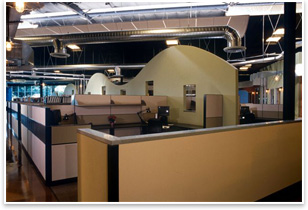 Paying it forward Paying it forward
Chief Operating Officer Susan Whalen says that one far-reaching result of the LEED process and RRM’s effort is that the process continues to have an impact beyond the renovation. “We did a ‘pay it forward’ when we started this process. We handed out fluorescent light bulbs and asked employees to pay that forward,” explains Whalen. “A lot of people put them in their homes and then passed that on to others. We also had a person from the municipal Waste Management agency come and educate our staff about recycling and trash, and a lot of people took that home and implemented that process there. It’s become very contagious. A lot of people have changed their lifestyle because of it. It’s picked up the morale and has motivated them to become LEED accredited professionals.
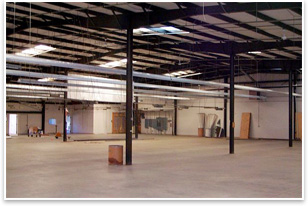 “Most importantly, the LEED process gave us a chance to evaluate what we purchase, how our facility functions, and how we operate our business,” believes Whalen. “Through this introspection, we discovered that we can continue to be good stewards of the earth, operate our business more efficiently, and enjoy the added benefit of financial savings.” “Most importantly, the LEED process gave us a chance to evaluate what we purchase, how our facility functions, and how we operate our business,” believes Whalen. “Through this introspection, we discovered that we can continue to be good stewards of the earth, operate our business more efficiently, and enjoy the added benefit of financial savings.”
“Our experience has made a relatively big impact in our community here in San Luis Obispo,” White concludes. “Once we went through the process, our local chamber of commerce has agreed to go through it as well, and there are several other companies in the area that have committed to doing it. For very, very little cost investment, companies are able to save money and reduce their impact, which I think is a very powerful thing. All it’s really about is taking a look inside.” | 


